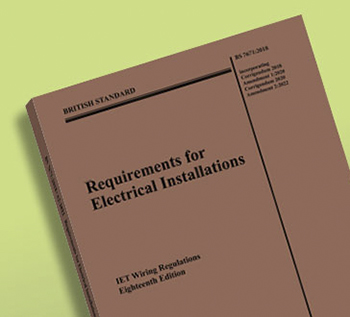Requirements for electrical installations amendment 4 consultation
On 6 August 2024, ECA announced it is calling on its Members and the wider industry to submit their comments on the proposed Amendment 4 to the current edition of the Wiring Regulations BS 7671:2018 Amendment 2 (2022) + Amendment 3 (2024).
The DPC (Draft for Public Consultation) on the amendment opened on 6 August 2024 and closes on 1 November 2024 at 5pm. Throughout this period, ECA will be supporting its Members via our technical helpline, a video series and a live webinar hosted by the ECA Technical Team.
The greatly anticipated amendment will incorporate changes to harmonised standards at European level which the UK has to adopt within a certain time period. Until the amendment is published in 2026, ECA Members must have a copy of Amendment 2 (2022) - the ‘brown book’ and Amendment 3 (2024) free PDF bolt-on) to be up to date.
ECA’s Technical Manager Darren Crannis said: “We welcome this proposed amendment, which crucially considers fast evolving technologies supporting a safe transition to net zero. The amendment will further equip ECA Members with the new requirements to safety design and install stationary secondary batteries, low voltage generation sets, power over Ethernet (PoE) and functional earthing and bonding for communication technology equipment (ICT). The ECA Technical team are ready to support ECA Members, and the wider electrotechnical community, with the proposed changes and we encourage you to make comments via the BSI portal or to ECA at [email protected].”
The Institution of Engineering and Technology (IET) and BSI jointly manage JPEL/64, the committee responsible for BS 7671, of which ECA is a key member.
For more information and to submit your comments on the DPC, visit this page. Sign up to the Member-exclusive Amendment 4 DPC webinar on Tuesday 20 August here.
ECA’s industry-leading Technical Team offers unrivalled support across a wide range of electrotechnical activities. Members can access exclusive application guides, editable certificates, guidance notes, technical bulletins, and access to the ECA Technical Helpline. Find out more.
This article originally appeared on the ECA website on 6 August 2024.
--ECA
[edit] Related articles on Designing Buildings
- 18th Edition Wiring Regulations.
- Amendment 2 18th Edition Wiring Regulations BS 7671 come into full effect.
- Articles by the Electrical Contractors' Association (ECA).
- BS 7671 Requirements for Electrical Installations.
- Corrigendum to the 18th Edition Wiring Regulations.
- ECA.
- IET announces release of 18th Edition Amendment 2.
- Institution of Engineering and Technology.
Featured articles and news
Homes England creates largest housing-led site in the North
Successful, 34 hectare land acquisition with the residential allocation now completed.
Scottish apprenticeship training proposals
General support although better accountability and transparency is sought.
The history of building regulations
A story of belated action in response to crisis.
Moisture, fire safety and emerging trends in living walls
How wet is your wall?
Current policy explained and newly published consultation by the UK and Welsh Governments.
British architecture 1919–39. Book review.
Conservation of listed prefabs in Moseley.
Energy industry calls for urgent reform.
Heritage staff wellbeing at work survey.
A five minute introduction.
50th Golden anniversary ECA Edmundson apprentice award
Showcasing the very best electrotechnical and engineering services for half a century.
Welsh government consults on HRBs and reg changes
Seeking feedback on a new regulatory regime and a broad range of issues.
CIOB Client Guide (2nd edition) March 2025
Free download covering statutory dutyholder roles under the Building Safety Act and much more.
Minister quizzed, as responsibility transfers to MHCLG and BSR publishes new building control guidance.
UK environmental regulations reform 2025
Amid wider new approaches to ensure regulators and regulation support growth.
BSRIA Statutory Compliance Inspection Checklist
BG80/2025 now significantly updated to include requirements related to important changes in legislation.
























